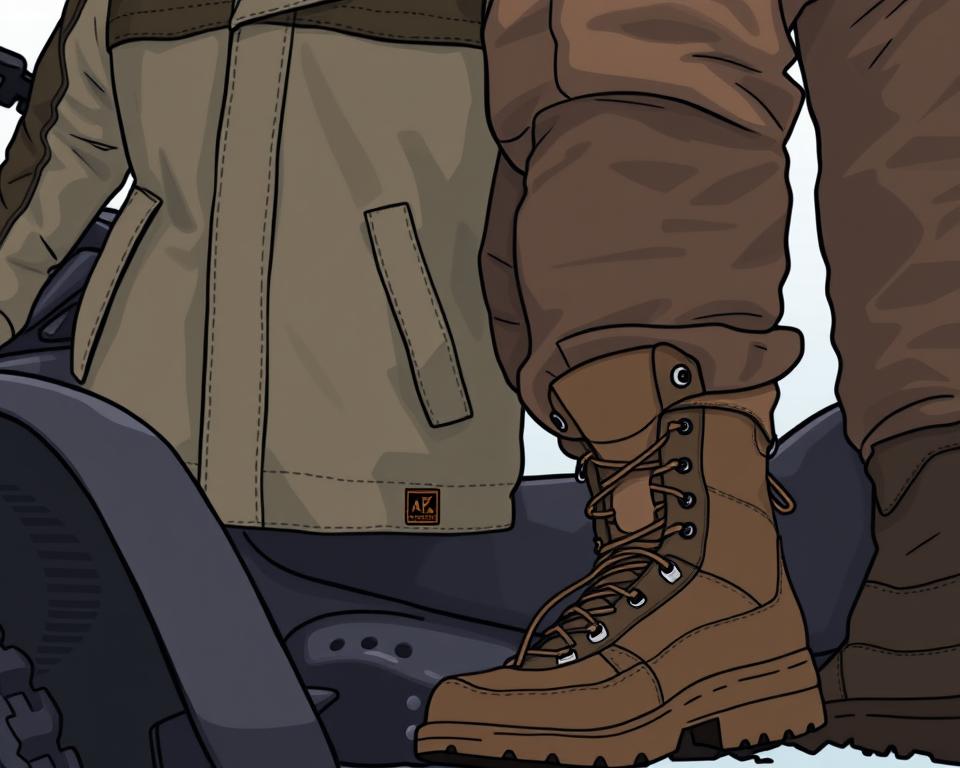How New Riders Can Avoid ATV/UTV Gear Selection Pitfalls
Did you know that nearly 20% of new ATV and UTV owners face gear selection issues within their first year? That figure highlights why beginners need to understand ATV gear ratios. Beyond performance, proper gearing is a key safety factor. Let’s dive into gearing missteps, care routines, and top warn winchs tips to enhance your rides.
Key Takeaways

- Understanding gear ratios is vital for optimal ATV/UTV performance.
- Typical gear mistakes compromise safety on uneven ground.
- Routine care averts transmission breakdowns.
- Proper gear selection greatly enhances off-road riding experiences.
- Following upkeep advice extends your ATV’s life.
Understanding ATV and UTV Gear Ratios
Ratios determine how engine output translates to drive force. They govern both top speed and hauling capacity. This affects acceleration and the vehicle’s ability to pull loads. Custom gearing shifts focus from speed to torque or vice versa.
Selecting proper gears unlocks engine potential. A low gear ratio can hinder torque during steep climbs or when carrying heavy loads. Conversely, too high a ratio hampers quick takeoffs on flats.
Many enthusiasts use gear reduction to enhance handling and adaptability across different terrains. Ratio mods shape how your rig behaves off-road. It perfectly aligns performance with your riding style. Achieving the right balance in ATV gear ratios improves the driving experience and boosts efficiency.
Common Gearing Oversights for New ATV/UTV Owners
Proper gear choice underpins both power and protection. Rookies often miss key selection factors. Understanding the effects of wrong gear choices and selecting the right one for your terrain can greatly improve your ride. Plus, it prevents mechanical setbacks.
Impact of Incorrect Gear Selection
Misgearing risks crashes and costly damage. The wrong gear can slow down acceleration, affect braking, and cause excessive wear. These mishaps compromise safety for all on and off board. Using maintenance best practices wards off these hazards.
Choosing the Right Gear for Terrain
Trail type dictates ideal gearing. Climbing requires low-end grunt from smaller ratios. Flats call for taller ratios to boost top-end. Mucky surfaces require cautious gearing to maintain momentum. Recognizing terrain traits delivers safer, smoother rides.
The Importance of Proper ATV Maintenance
Routine upkeep ensures reliable performance. Using upkeep best practices stops breakdowns and protects riders. A tailored service plan prioritizes drivetrain care.
Regular Inspection and Maintenance
Using a checklist uncovers faults before they escalate. Routinely examine gearbox teeth, brake pads, rubber, and belts. By making this checklist a part of your routine, you can greatly enhance your vehicle’s performance. Here are some critical inspection points to remember:
- Inspect gearbox alignment and pitting.
- Verify hardware and linkages are secure.
- Inspect brake lines and levels.
- Inspect tire pressure and tread depth.
- Inspect battery terminals and cables for buildup.
Fluid Changes and Gear Health
Fluid quality is critical for UTV drivetrain maintenance. Regularly changing engine oil, gear oil, and coolant prevents grime buildup. Pure coolant and oil lower temperatures and prolong service intervals. Adopting this routine preserves drivetrain health and trail readiness.
| Fluid Type | Recommended Change Interval | Benefits of Regular Change |
|---|---|---|
| Engine Oil | 50–100 operating hours | Reduces engine wear, enhances performance |
| Gear Oil | Every 100-200 hours | Smooths shifts and prevents pitting |
| Coolant | Once per year | Stops boil-overs and freezes |
Sticking to this plan ensures uninterrupted trail fun. That boosts confidence and enjoyment.
Common ATV Gear Shifting Problems
Rookie riders struggle with smooth shifts. Learning silky shift methods transforms your ride. This stops shift-related aggravation. Synchronizing engine speed and clutch engagement stops misshifts.
Learning to Shift Smoothly
Developing smooth shifting techniques requires a few practices. Start by getting to know your ATV engine’s rhythm. Gentle shifts spare your gearbox and extend service life. Blending throttle with clutch release ensures seamless shifts.
Practice shifting in a controlled setting until you’re confident. Keep your throttle light when shifting.
Recognizing Signs of Gear Issues
Spotting problems early prevents breakdowns. Listen for unusual sounds like grinding or popping, which may mean gears aren’t engaging right. Hard shifts or missed gears indicate trouble. Fixing problems fast keeps you safer on the trail. Addressing ATV gear shifting problems properly maintains vehicle performance and boosts your confidence while riding.
Understanding UTV Transmission Issues
Dealing with UTV transmission problems can be tough, but knowing the common issues is vital for troubleshooting. Owners often face issues like slipping gears or odd noises. Below we break down common failures and the tools to troubleshoot them. Leveraging user-friendly diagnostic procedures.
Diagnosing Common Problems
Noticing early clues saves you from expensive repairs. Common issues include:
- Unexpected gear drops that compromise handling.
- Strange noises signaling internal wear.
- Drips or puddles under the UTV may foretell failures.
Regular gear diagnostics help spot these issues quickly. This allows for prompt action. Missing early clues damages your ride and wallet.
Solutions for Troubleshooting UTV Transmissions
Repairing gearbox problems calls for methodical steps. Follow these steps for effective troubleshooting:
- Ensure gearbox fluid is at spec, then add if low.
- Examine for any leaks under the vehicle.
- Assess internal components for wear or chipping.
- Test drive the UTV at various speeds to monitor gear engagement and responsiveness.
- Consult the owner’s manual for specific diagnostics related to your model.
Following a reputable repair manual simplifies diagnosis. Knowing how transmissions work benefits every rider. It greatly enhances your vehicle’s longevity and efficiency.
ATV Clutch Adjustments and Their Benefits
Right clutch settings smooth out gear changes. Incorrect adjustments can make shifting gears tough, frustrating for beginners. Routine calibration refines clutch response and engagement.
Precision in gear changes is critical. A well-set clutch delivers fast, clean shifts. It refines acceleration and comfort across all conditions.
Neglecting clutch upkeep accelerates wear and reduces power. Regular tuning keeps shifts sharp and the motor lively. It’s critical for both new and seasoned riders to ensure their ATV performs at its best.
Mastering the Art of Gear Shifting
Becoming adept at shifts transforms your off-road sessions. Understanding drivetrain function and shift timing is crucial. Rookies need to practice gear timing. A steady shift rhythm yields cleaner transitions and more power.
Skillful shifting comes from drilling in diverse environments. Recognizing terrain-specific shift cues boosts confidence and protection. Dropping a gear before a climb preserves torque and control.
- Rehearse clicks slowly to gain control.
- Observe how your vehicle responds to different shifts.
- Gradually incorporate more challenging terrains to test your skills.
Tuning into your ATV’s feedback is key to shift mastery. Pay attention to engine sounds and vibrations. These cues pinpoint exact shift timing. Such intuitive understanding leads to proficient gear shifting, making your ride more enjoyable.
Best Practices for UTV Gear Selector Problems
Managing UTV gear selector problems demands a proactive maintenance and diagnostic approach. Frequent selector checks prevent surprises. Perfecting selector methods wards off glitches. Routine checks should include visual inspections of the selector linkage and fluid levels, which are vital for performance.
If you suspect a fault, inspect the lever assembly for bends or breaks. Squeaks might indicate misalignment. A quick tighten or lube can restore function. An organized maintenance schedule helps manage wear and tear.
Tracking shift quality across terrains isolates faults. Following these methods preserves selector health and rider trust.
Tips for Enhancing Gear Performance
Achieving top drivetrain function demands regular attention. Routine service boosts ATV efficiency. It’s important to check fluid levels, inspect for wear, and adjust settings as needed. Spotting wear early stops expensive overhauls.
Choosing the right gear ratios is essential for maximizing engine response and achieving a smoother ride. Understanding the terrain you will face allows you to select the appropriate ratios. This decision impacts everything from acceleration to top speed. Consulting reputable brands like American Off-Roads, which offer aftermarket modifications, can help with UTV performance enhancements.
Applying gear performance tips across tires, shocks, and load balance boosts efficiency. Making these adjustments ensures that both ATVs and UTVs handle better in challenging environments. You’ll notice more thrill and less stress on every trip. These steps ensure fearless exploration and maximum excitement on the trail.
Bringing It All Together
Nailing gear selection unlocks peak power and protection. Selecting proper ratios for each trail elevates your experience. Steering clear of rookie errors and picking wisely ensures safe, thrilling rides.
The importance of performance maintenance cannot be overstated. Scheduled maintenance and TLC save you from breakdowns and prolong service. Proper care boosts efficiency and keeps you safe in diverse environments.
Combining correct gearing with scheduled service delivers peak satisfaction for riders. Embracing these tips sets the stage for countless epic journeys.
Frequently Asked Questions
What are the typical gear ratios for ATVs and UTVs?
Gear ratios span a broad spectrum across makes and models. Typical ratios lie within the 3-to-5 range. Smaller ratios deliver grunt for trails and climbs. Higher ratios, on the other hand, can increase top speed on flat terrain.
How can I determine if I’m using the wrong gear for my terrain?
Wrong ratios cause skiddy control, engine lugging, or weak pull. Different grounds need dedicated ratios to maintain traction and speed.
How to know when your machine needs service?
Look out for signs like difficulty shifting gears, unusual noises from the transmission, fluid leaks, or a decrease in performance. Regular checks of the gear system can prevent major issues.
How often should I change the fluids in my ATV/UTV gear system?
Change the gear fluids every 1,500 to 2,500 miles, or at least once a year, depending on usage and terrain. Pure oils maintain smooth shifts and protect internals over time.
Best practices for flawless shifts?
Sync your revs and clutch for seamless gear changes. Ease out the clutch as you roll on the throttle to align RPM and road speed.
Steps to diagnose gearbox problems?
Start by checking for common problems like slipping gears or strange noises. Inspect the transmission fluid level and condition. Then, perform a basic diagnostic to identify any mechanical failures.
What is the importance of clutch adjustments in an ATV?
Proper clutch adjustments are essential for smooth gear transitions. Incorrect clutch setup strains the gearbox and causes sticky shifts.
Optimizing gears for varied ground?
Experiment with various gear ratios and consider aftermarket modifications from reputable brands like American Off-Roads. Routine upkeep—fluid swaps and gear checks—boosts efficiency.
What should I do if my UTV gear selector is malfunctioning?
Regular inspections and routine maintenance are key. If you encounter issues with a stuck selector or improper gear engagement, consult the troubleshooting guide in your owner’s manual for step-by-step diagnostics.
Rookie gearing errors to dodge?
Rookies tend to ignore ratio basics, delay upkeep, or misgear for mud, rock, or hills. These oversights can lead to inefficient operation and safety concerns.
